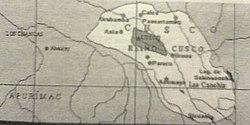Kingdom of Cusco
| Kingdom of Cuzco | ||||||||||
|
||||||||||
|
Map of the Kingdom of Cusco.
|
||||||||||
| Capital | Cusco | |||||||||
| Languages | Quechua, Puquina. | |||||||||
| Religion | Inca religion | |||||||||
| Government | Monarchy | |||||||||
| Sapa Inca | ||||||||||
| • | 1200-1230 | Manco Cápac | ||||||||
| • | 1230-1260 | Sinchi Roca | ||||||||
| • | 1260-1290 | Lloque Yupanqui | ||||||||
| • | 1290-1320 | Mayta Cápac | ||||||||
| • | 1320-1350 | Cápac Yupanqui | ||||||||
| • | 1350-1380 | Inca Roca | ||||||||
| • | 1380-1410 | Yahuar Huacac | ||||||||
| • | 1410-1438 | Viracocha (Inca) | ||||||||
| Historical era | Pre-Columbian | |||||||||
| • | Manco Cápac organized the Kingdom of Cusco | 1197 | ||||||||
| • | Pachacuti created the Tawantinsuyu | 1438 | ||||||||
| Area | 40,000 km² (15,444 sq mi) | |||||||||
|
||||||||||
| Today part of |
|
|||||||||
The Kingdom of Cusco (sometimes spelled Cuzco and in Quechua Qosqo or Qusqu) was a small kingdom based in Cusco on the Andean mountain ranges that began as a small city-state founded by the Incas around the 12th century. In time, through either warfare or peaceful assimilation, it began to grow and was succeeded by the Inca Empire (1438-1533).
The Inca people began as a tribe in the Cuzco area around the 12th century AD. Under the leadership of Manco Cápac, they formed the small city-state of Cusco (Quechua Qosqo), shown in red on the map below.
In 1438 AD, under the command of the Sapa Inca (paramount leader) Pachacuti (world-shaker), the Incas began a far-reaching expansion. The land which Pachacuti conquered was about the size of the Thirteen Colonies at the outbreak of the American Revolution of 1776, and consisted of nearly the entire territory of the Andes mountain range.
Pachacuti reorganized the kingdom of Cusco into an empire, the Tahuantinsuyu, a federalist system that consisted of a central government with the Inca at its head and four provincial governments with strong leaders: Chinchasuyu (NW), Antisuyu (NE), Kuntisuyu (SW), and Qullasuyu (SE). Pachacuti is thought to have built the citadel of Machu Picchu, either as a family home or as a vacation estate.
The Sapa Inca of the first dynasty of the Kingdom of Cusco were, in order, Manco Cápac, Sinchi Roca, Lloque Yupanqui, Mayta Cápac, and Cápac Yupanqui. Evidence of state organization dates from 1200 AD. Little is known of this population, but in later years the meaning of cápac meant warlord and sinchi meant leader adding to the idea they could have been rulers.
...
Wikipedia

